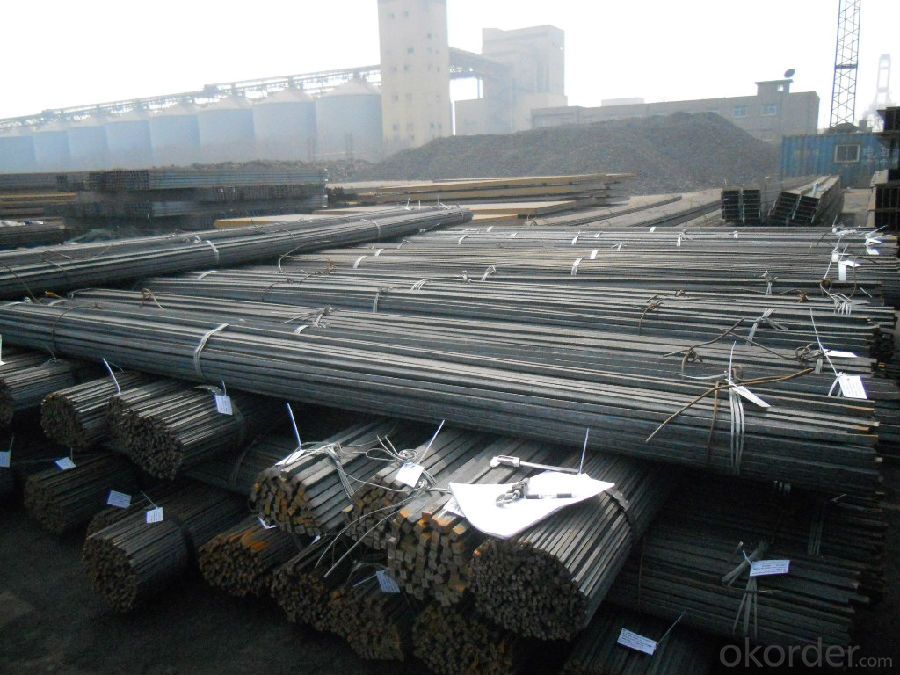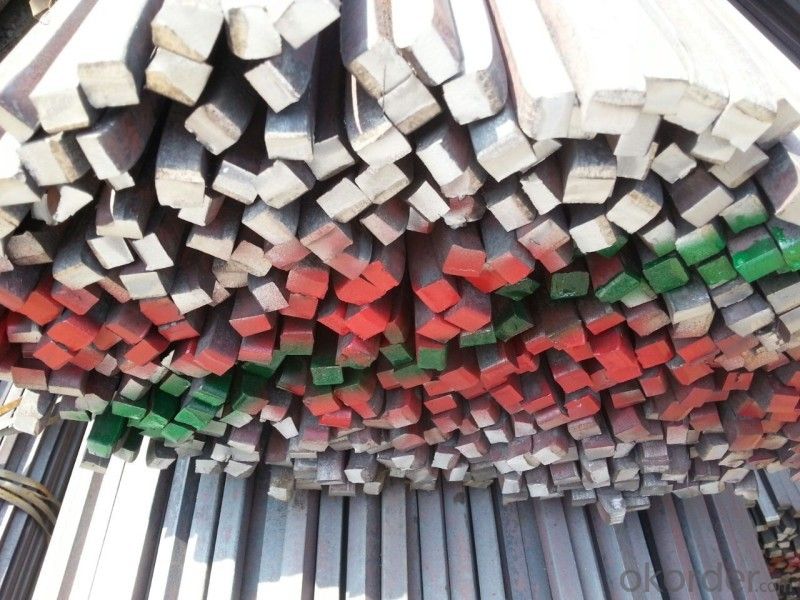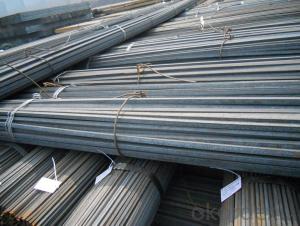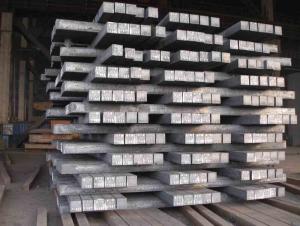Hot Rolled Low Carbon Steel Square Bars
- Loading Port:
- China main port
- Payment Terms:
- TT OR LC
- Min Order Qty:
- 100 m.t.
- Supply Capability:
- 5000 m.t./month
OKorder Service Pledge
OKorder Financial Service
You Might Also Like
Product Description:
OKorder is offering Hot Rolled Low Carbon Steel Square Bars at great prices with worldwide shipping. Our supplier is a world-class manufacturer of steel, with our products utilized the world over. OKorder annually supplies products to African, South American and Asian markets. We provide quotations within 24 hours of receiving an inquiry and guarantee competitive prices.
Product Applications:
Hot Rolled Low Carbon Steel Square Bars are ideal for structural applications and are widely used in the construction of buildings and bridges, and the manufacturing, petrochemical, and transportation industries.
Product Advantages:
OKorder's Hot Rolled Low Carbon Steel Square Bars are durable, strong, and wide variety of sizes.
Main Product Features:
· Premium quality
· Prompt delivery & seaworthy packing (30 days after receiving deposit)
· Can be recycled and reused
· Mill test certification
· Professional Service
· Competitive pricing
Product Specifications:
Manufacture: Hot rolled
Grade: Q195 – 235
Certificates: ISO, SGS, BV, CIQ
Length: 6m – 12m, as per customer request
Packaging: Export packing, nude packing, bundled
| SQUARE BAR | |
| SIZE a(mm) | theoretical kg/m |
| 5.5 | 0.237 |
| 6 | 0.283 |
| 7 | 0.385 |
| 8 | 0.502 |
| 9 | 0.636 |
| 10 | 0.785 |
| 11 | 0.95 |
| 12 | 1.13 |
| 13 | 1.33 |
| 14 | 1.54 |
| 15 | 1.77 |
| 16 | 2.01 |
| 17 | 2.27 |
| 18 | 2.54 |
| 19 | 2.83 |
| 20 | 3.14 |
| 21 | 3.46 |
| 22 | 3.8 |
| 24 | 4.52 |
| 25 | 4.91 |
| 26 | 5.31 |
| 28 | 6.15 |
| 30 | 7.06 |
| 32 | 8.04 |
| 34 | 9.07 |
| 36 | 10.2 |
| 38 | 11.3 |
| 40 | 12.6 |
| 42 | 13.8 |
| 45 | 15.9 |
| 48 | 18.1 |
| 50 | 19.6 |
| 53 | 22 |
| 56 | 24.6 |
| 60 | 28.3 |
FAQ:
Q1: Why buy Materials & Equipment from OKorder.com?
A1: All products offered byOKorder.com are carefully selected from China's most reliable manufacturing enterprises. Through its ISO certifications, OKorder.com adheres to the highest standards and a commitment to supply chain safety and customer satisfaction.
Q2: How do we guarantee the quality of our products?
A2: We have established an advanced quality management system which conducts strict quality tests at every step, from raw materials to the final product. At the same time, we provide extensive follow-up service assurances as required.
Q3: How many tons of steel products could be loaded in containers?
A3: Usually the steel products are delivered by bulk vessel because of the large quantity and the freight. However, there are no bulk vessel enter some seaports so that we have to deliver the cargo by containers. The 6m steel product can be loaded in 20FT container, but the quantity is changed according to the size, usually from 18tons to 25tons.
Images:


- Q:How do you use a steel square to determine angles for stair nosing?
- In order to determine angles for stair nosing using a steel square, the following steps should be followed: 1. Align one leg of the steel square with the vertical riser and the other leg with the horizontal tread, placing the square on the edge of the stair tread. 2. Ensure that the square is securely positioned against the edge of the tread and riser to obtain precise measurements. 3. Mark the angle on the tread using a pencil or marker, once the square is properly aligned. 4. Transfer the marked angle onto the stair nosing material by placing the square against it, aligning the leg with the edge that will be installed on the stair tread. 5. Mark the angle on the material using a pencil or marker, making sure that the line is clear and visible. 6. Cut along the marked line using a saw or appropriate cutting tool to obtain the correct angle for the stair nosing. By utilizing a steel square in this manner, one can accurately determine and transfer angles onto stair nosing material, resulting in a precise fit and a professional-looking finish for the stairs.
- Q:How do you determine if a steel square is square?
- To determine the squareness of a steel square, one must carry out a straightforward test known as the "4-5-6 method." This method entails measuring the diagonals of the square and verifying their equality. Begin by placing the steel square on a level surface or workbench, ensuring its correct alignment by aligning one edge with a straight edge or wall to prevent any movement. Next, measure one side of the square and label it as "4 units." Then, measure another side perpendicular to the first and label it as "5 units." Proceed to measure the diagonal from the starting point of the 4-unit side to the endpoint of the 5-unit side. If the square is perfectly square, this diagonal should precisely measure 6 units. Repeat this procedure for the other diagonal by measuring from the starting point of the 5-unit side to the endpoint of the 4-unit side. Again, this diagonal should also measure exactly 6 units. If both diagonals measure precisely 6 units, then the steel square is square. However, even a slight disparity in the measurements indicates that the square is not perfectly square. In such instances, it is advisable to compare the square against a known accurate reference, such as another steel square or a reliable measuring tool, to confirm its squareness.
- Q:Can a steel square be used for checking the squareness of shelf brackets?
- Certainly! The squareness of shelf brackets can indeed be checked with the aid of a steel square. An incredibly versatile tool, the steel square is frequently employed in carpentry and woodworking to assess the precision of right angles. By positioning the steel square against the corner of the shelf bracket, one can ascertain whether it is impeccably square or necessitates any modifications. Additionally, the straight edge of the steel square may be utilized to verify the appropriate alignment of the bracket with the shelf or wall. All in all, the employment of a steel square proves to be a highly effective means of examining the squareness of shelf brackets.
- Q:How do you use a steel square to measure and mark 146.25-degree angles?
- To use a steel square to measure and mark a 146.25-degree angle, you would follow these steps: 1. Start by aligning the long edge of the steel square with the baseline of the angle you want to measure and mark. 2. Make sure the 90-degree angle (also known as the right angle) of the square is positioned accurately against the surface or edge where you want to create the angle. 3. Next, find the degree markings on the steel square. Typically, these markings will be found on the outer edge of the square and will range from 0 to 180 degrees. 4. Begin by locating the 0-degree mark on the steel square. This mark will be on the right-hand side of the square, opposite the right angle. 5. From the 0-degree mark, count clockwise until you reach the 146.25-degree mark. You can use the degree markings on the square to guide you. It can be helpful to use a magnifying glass if the markings are small. 6. Once you have located the 146.25-degree mark, make a small pencil mark on the surface or edge you are working on. 7. Finally, use a straight edge, such as a ruler or another edge of the steel square, to connect the pencil mark to the baseline of the angle, creating the desired 146.25-degree angle. It is important to note that some steel squares may not have degree markings beyond 90 degrees. In this case, you may need to use additional tools, such as a protractor or a digital angle finder, to accurately measure and mark a 146.25-degree angle.
- Q:How do you use a steel square to lay out a tenon joint?
- To use a steel square to lay out a tenon joint, start by marking the width of the tenon on the end of the board using the square's blade. Then, use the square's tongue to mark the shoulder line by aligning it with the edge of the board. Next, mark the depth of the tenon by positioning the square's blade against the face of the board. Finally, connect the marks to outline the tenon and repeat the process on the corresponding mortise piece for a precise and accurate joint.
- Q:Can a steel square be used for setting up a planer?
- Yes, a steel square can be used for setting up a planer. A steel square is a versatile tool that can be used for measuring and checking right angles, which is essential when aligning the planer's fence and table. It provides a reliable reference point to ensure accurate and precise adjustments, resulting in a properly set-up planer.
- Q:Are there any limitations to using a steel square?
- Yes, there are some limitations to using a steel square. Firstly, the size and weight of a steel square can make it difficult to handle, especially for individuals with limited strength or dexterity. This can make it challenging to use the square for prolonged periods or in complex projects where precise measurements are required. Secondly, steel squares are typically designed for right angles and straight measurements, which means they may not be suitable for projects that involve angles other than 90 degrees. In such cases, additional tools or techniques may be required to achieve the desired angles accurately. Thirdly, steel squares can be susceptible to rust and corrosion if not properly maintained. This can affect their accuracy over time, requiring regular cleaning and maintenance to ensure reliable measurements. Lastly, steel squares may not be suitable for certain materials or surfaces. For example, using a steel square on delicate or easily scratched materials like polished wood or glass may cause damage. In such cases, alternative measuring tools or protective measures may be necessary. Despite these limitations, steel squares are still widely used and valued for their sturdiness, durability, and accuracy in many woodworking, metalworking, and construction projects. However, it is important to be aware of their limitations and adapt accordingly when necessary.
- Q:Can a steel square be used for wainscoting installation?
- Yes, a steel square can be used for wainscoting installation. A steel square is a versatile and durable tool that is commonly used in carpentry and woodworking projects. Its primary purpose is to assist in measuring and marking right angles and ensuring accurate cuts and joinery. When installing wainscoting, a steel square can be used to mark and measure the height and width of the panels, as well as to ensure proper alignment and levelness during installation. It can also be used to check for squareness and make precise cuts when trimming the panels to fit around corners or obstacles. Overall, a steel square can be a valuable tool for achieving precise and professional-looking wainscoting installation.
- Q:Can a steel square be used for gazebo construction?
- Gazebo construction can indeed benefit from the utilization of a steel square. These versatile tools serve multiple purposes such as angle measurement, marking, ensuring squareness, and facilitating precise and accurate construction. Carpenters and builders frequently employ steel squares in various construction projects, including the construction of gazebos. By implementing a steel square, one can effectively establish and mark the necessary angles and cuts for the gazebo frame, guaranteeing proper alignment and squareness of the structure. Furthermore, during the assembly process, the steel square can be employed to verify squareness, thereby ensuring compliance with the desired specifications. In conclusion, a steel square is an invaluable tool that contributes significantly to the success of gazebo construction.
- Q:How do you use a steel square to determine the slope of a roof?
- To use a steel square to determine the slope of a roof, you will need to follow these steps: 1. Position yourself at the bottom edge of the roof where you want to measure the slope. 2. Hold the steel square against the edge of the roof, with one arm resting on the roof surface and the other arm extending vertically. 3. Adjust the vertical arm of the steel square until it is perfectly plumb, meaning it is aligned with the vertical direction. 4. While keeping the steel square steady, observe the horizontal arm. Note that it has markings and numbers representing different angles, typically ranging from 0 to 90 degrees. 5. Identify the marking on the horizontal arm that aligns with the roof surface. For example, if the horizontal arm aligns with the roof at the 4-inch marking, you would consider this as a 4-inch rise over a 12-inch run. 6. Convert the rise and run measurements into a ratio or fraction to represent the slope. In this example, the ratio would be 4:12 or the fraction 1/3, indicating that the roof has a slope of 1/3 or 4:12. Remember that the markings on the steel square are typically standardized and designed for common roof slope measurements. However, it may be necessary to refer to a conversion chart or consult an engineer if the slope is outside the range of the steel square markings.
1. Manufacturer Overview |
|
|---|---|
| Location | |
| Year Established | |
| Annual Output Value | |
| Main Markets | |
| Company Certifications | |
2. Manufacturer Certificates |
|
|---|---|
| a) Certification Name | |
| Range | |
| Reference | |
| Validity Period | |
3. Manufacturer Capability |
|
|---|---|
| a)Trade Capacity | |
| Nearest Port | |
| Export Percentage | |
| No.of Employees in Trade Department | |
| Language Spoken: | |
| b)Factory Information | |
| Factory Size: | |
| No. of Production Lines | |
| Contract Manufacturing | |
| Product Price Range | |
Send your message to us
Hot Rolled Low Carbon Steel Square Bars
- Loading Port:
- China main port
- Payment Terms:
- TT OR LC
- Min Order Qty:
- 100 m.t.
- Supply Capability:
- 5000 m.t./month
OKorder Service Pledge
OKorder Financial Service
Similar products
New products
Hot products
Related keywords


























